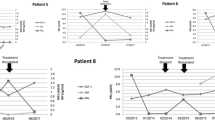Abstract
Terguride, a derivative of lisuride, has been shown to possess a mixed dopaminergic-antidopaminergic activity in experimental models. We have studied the effects on PRL and GH levels of 0.2 mg po of terguride in 8 normal subjects, in 15 patients with pathological hyperprolactinemia (PHP) and in 17 patients with active acromegaly. In PHP, PRL levels were significantly reduced up to 300 min after terguride with a nadir (45 ± 4.0 % SE) significantly lower (p< 0.05) than the one observed in the 8 normal subjects (72 ± 3.5%). There was no significant difference in plasma PRL levels after 0.2 mg terguride or lisuride in 7 out of 15 patients tested with both drugs. Terguride did not significantly modify GH levels in PHP and in normals but when considering basal and peak (occurring between 60 and 150 min) GH values, a significant difference was found (p< 0.01 ). Mean peak of GH did not differ significantly between PHP (5.0 ± 1.1 ng/ml) and normals (6.8 ± 1.7 ng/ml). Plasma GH levels of 17 acromegalics were not modified by 0.2 mg of terguride but were significantly reduced by 2.5 mg of bromocriptine. Terguride and bromocriptine reduced PRL levels in acromegalics (p< 0.01 ) without any significant difference between the two drug. 0.2 mg terguride b i d given for 15 days to 7 healthy volunteers significantly reduced both basal and sulpiride (25 mg im) — stimulated PRL levels. Side effects were observed only in 4 out of 47 subjects tested with terguride and in 8 out of 34 tested with bromocriptine.
Similar content being viewed by others
References
Verde G., Chiodini P.G., Liuzzi A., Cozzi R., Favales F., Botalla L., Dallabonzana D., Rainer E., Horowski R. Effectiveness of the dopamine agonist lisuride in the medical treatment of acromegaly and pathological hy-perprolactinemia. J. Endocrinol. Invest. 4: 405, 1980.
Liuzzi A., Chiodini P.G., Dallabonzana D., Spelta V., Silvestrini F., Rainer E., Horowski R. Medical treatment of pituitary adenomas. In: Calne D.V., Horowski R., McDonald R.J., Wuttke W. (Eds.), Lisuride and other dopamine agonists. Raven Press, New York, 1983, p. 238.
Wachtel H. Central dopaminergic and antidopaminergic effect of ergot derivatives structurally related to lisuride. In: Calne D.B., Horowski R., Mc Donald R.J., Wuttke W. (Eds.), Lisuride and other dopamine agonists. Raven Press, New York, 1983, p. 109.
Kehr W., Wachtel H., Schneider H.H. Dopaminergic and antidopaminergic properties of ergo-lines structurally related to lisuride. In: Carlsson A., Lars J., Nilsson G., (Eds.), Dopamine receptor agonists proceedings 2. Acta Pharm. Suec. (Suppl. 2): 98, 1983.
Wachtel H., Dorow R. Dual action on central dopamine function of transdihy-drolisuride a 9-10 dihydrogenate analogue of the ergot dopamine agonist lisuride. Life Sci. 32: 421, 1983.
Malarkey W.B., Daughaday W.H. The influence of levodopa and adrenergic blockade on GH and PRL secretion in the MTW-15 tumor bearing rat. Endocrinology 91: 1314, 1972.
Bansal S., Lee LA., Woolf P.D. Abnormal prolactin responsivity to dopaminergic suppression in hyperprolactinemic patients Am. J. Med. 71: 961, 1981.
Oppizzi G., Dallabonzana D., Spelta V., Silvestrini F., Chiodini P.G., Liuzzi A. Variable PRL inhibition by low doses of dopamine in pathological hyperprolactinemia. 65th Meeting Endocr. Soc, June 8-10, 1983, S. Antonio (Abstract).
Camanni F., Massara F., Belforte L, Molinatti G.M. Changes in plasma growth hormone levefs in normal and acromegalic subjects following administration of 2-BR-alpha-ergocryptine. J. Clin. Endocrinol. Metab. 40: 363, 1975.
Dallabonzana D., Spelta V., Botalla L, Oppizzi G., Silvestrini F., Chiodini P.G., Liuzzi A. Effects of nomifensine on GH and PRL secretion in normal subjects and in pathological hyperprolactinemia. J. Clin. Endocrinol. Metab. 54: 1125, 1982.
Bression D., Brandi A.M., Novsbaum A., Peillon F. Evidence of dopaminergic receptors in human growth hormone (GH) secreting adenomas. Acta Endocrinol. (Kbh.) (Suppl. 243), 97: Abstract 411, 1981.
Author information
Authors and Affiliations
Additional information
Supported by CNR, Special Project “Control of Neoplastic Growth”, grant No. 820033496
Rights and permissions
About this article
Cite this article
Dallabonzana, D., Liuzzi, A., Oppizzi, G. et al. Effect of the new ergot derivative terguride on plasma PRL and GH levels in patients with pathological hyperprolactinemia or acromegaly. J Endocrinol Invest 8, 147–151 (1985). https://doi.org/10.1007/BF03350671
Received:
Accepted:
Published:
Issue Date:
DOI: https://doi.org/10.1007/BF03350671



